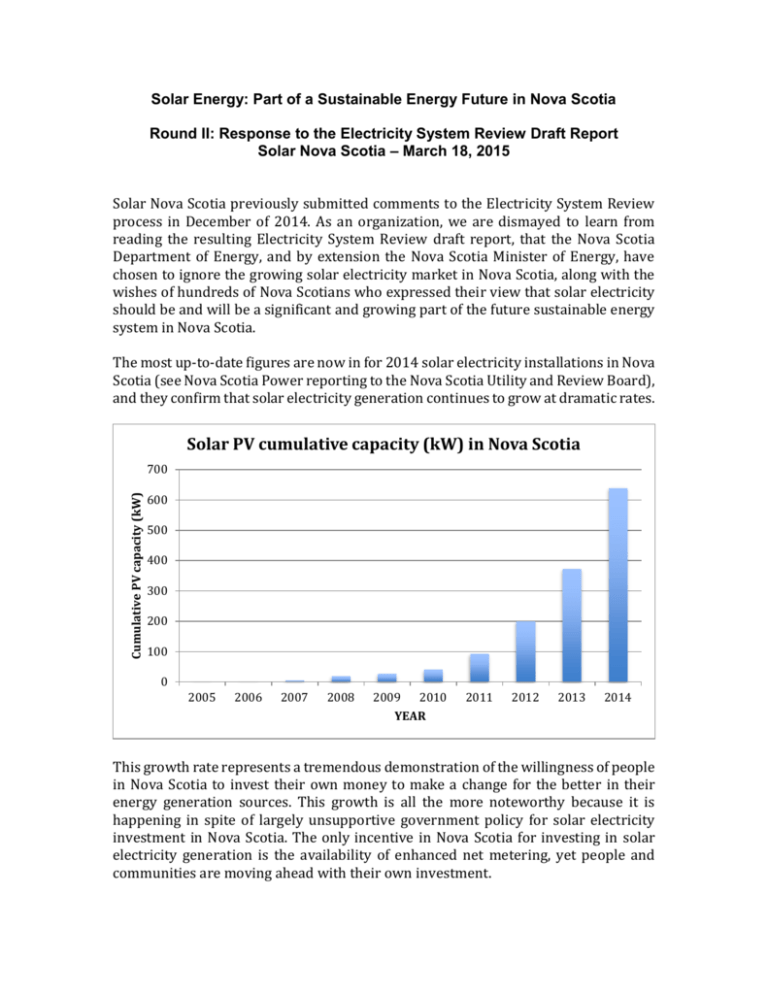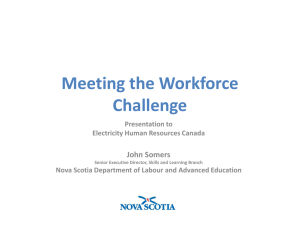Solar Nova Scotia - Nova Scotia Department of Energy
advertisement

Solar Energy: Part of a Sustainable Energy Future in Nova Scotia Round II: Response to the Electricity System Review Draft Report Solar Nova Scotia – March 18, 2015 Solar Nova Scotia previously submitted comments to the Electricity System Review process in December of 2014. As an organization, we are dismayed to learn from reading the resulting Electricity System Review draft report, that the Nova Scotia Department of Energy, and by extension the Nova Scotia Minister of Energy, have chosen to ignore the growing solar electricity market in Nova Scotia, along with the wishes of hundreds of Nova Scotians who expressed their view that solar electricity should be and will be a significant and growing part of the future sustainable energy system in Nova Scotia. The most up-to-date figures are now in for 2014 solar electricity installations in Nova Scotia (see Nova Scotia Power reporting to the Nova Scotia Utility and Review Board), and they confirm that solar electricity generation continues to grow at dramatic rates. Solar PV cumulative capacity (kW) in Nova Scotia Cumulative PV capacity (kW) 700 600 500 400 300 200 100 0 2005 2006 2007 2008 2009 2010 YEAR 2011 2012 2013 2014 This growth rate represents a tremendous demonstration of the willingness of people in Nova Scotia to invest their own money to make a change for the better in their energy generation sources. This growth is all the more noteworthy because it is happening in spite of largely unsupportive government policy for solar electricity investment in Nova Scotia. The only incentive in Nova Scotia for investing in solar electricity generation is the availability of enhanced net metering, yet people and communities are moving ahead with their own investment. This demonstrated will of people to invest in a sustainable energy future through distributed self-generation of solar electricity brings with it numerous benefits that have been neglected by the Department of Energy in its Electricity System Review, such as: - Investment of private dollars in the effort to slow down climate change and reduce air pollution; Creation of skilled jobs in solar energy system design, installation, and maintenance; Increased diversity of our renewable energy supply, complementing the large amount of wind energy on the system; Increased understanding and acceptance of the transition to renewable energy by bringing the opportunity to participate closer to home and within reach of more people; and, The connection to smart grid developments – we believe there is evidence to show that people with their own solar generation facilities will be more inclined to invest in smart control technology and electric vehicles to help manage the grid. In its draft report, the Department of Energy has chosen to focus only on perceived negative effects of widespread adoption of solar self-generation, in particular the idea that net-metered customers impose costs on other users of the electricity grid. It must be pointed out that; (1) all generators and users of the system share a variety of different costs, and some of those costs are largely unaccounted for now; for example the cost of air and carbon pollution from fossil-fueled generators; (2) the use of solar PV in a net metering context is not significantly different from and (2) the grid balancing costs (or benefits) for grid-connected solar PV have not been studied in Nova Scotia, and could be either positive or negative, significant or insignificant. Those costs and benefits of distributed solar electricity generation should be studied carefully, in a context of full cost accounting that includes all the other costs and benefits in the system. If it is found by a thorough and independent full cost accounting study that solar net metering generators are imposing a net cost on other people, then it would only be fair that solar generators pay their share. There is a relatively simple solution being implemented in some jurisdictions in the United States of America. The “minimum monthly bill” is a modest additional monthly connection fee (typically $5/month for residential systems) that balances the net difference in grid costs. In all fairness, such a system could be considered in Nova Scotia if it is demonstrated that there are quantifiable net costs to the system imposed by net metering generators. If nothing else, the discussion of the costs of grid services is a healthy discussion to have, because for too long the grid in Nova Scotia has been seen as a one-way conduit controlled by a very small number of entities, with generation, transmission, and distribution accounted for in the same fees and controlled by the same entities. Perhaps the business model needs to shift to one where the service provided by the grid is not so much generation, but rather an opportunity for exchange. In this vision of the future, the energy cost per kilowatt-hour becomes less relevant to the grid than the fee for the service of being connected and being able to exchange generation and storage capacity. On the topic of the capacity of the electricity system in Nova Scotia to use more solar electricity, the Department of Energy has chosen to continue to perpetuate incorrect statements, despite being presented with factual evidence that contradicts those statements. These errors were present in the original reports of the Electricity System Review, and they have not been corrected yet in the new draft version of the report: (1) The statement that solar electricity produces the most in the season when Nova Scotia needs electricity the least is incorrect according to the records of monthly demand and solar production. As Solar Nova Scotia pointed out in its original submission to the review process, in fact, solar electricity is produced at its maximum in Nova Scotia from June through August, and the lowest demand for electricity is in April/May and September/October. To give solar energy the consideration that is due, and that people in Nova Scotia are asking for, requires looking more closely at the basic facts. (2) More importantly, the Department of Energy has chosen to ignore the fact, despite its being pointed out twice now, that solar electricity is only produced in daytime, when Nova Scotia electricity demand is higher (year-round), by at least 200 MW than it is at night. This distinction is important because it means that there is daytime demand that can be supplied by self-generated solar electricity. We ask that the Nova Scotia government give more careful consideration to the role, benefits, and particular characteristics of solar electricity. (3) The report states that so-called “intermittent” (more accurately described as “variable”) sources of electricity like wind energy are already reaching their maximum in Nova Scotia in terms of accommodation on the grid, and implies that there is no room for solar electricity. However, these statements are based on wind energy integration studies, which do not take into account the different generation characteristics and timing of solar electricity. No independent, comprehensive, thirdparty study of solar energy integration has been done for Nova Scotia. Until such a study has been done, it is neither warranted nor defensible to state that a “limit” for solar has been reached. In terms of the broader sustainability goals of the electricity system, we see limited value in seeking input from members of the public without proactive engagement and mutual learning. We need to bring people together to ensure a common basis in terms of information, values, priorities and aspirations to be able to effectively use the opinions that are gathered. Opinions without context are useful in the sense that they tell you what perceptions you have to confront in moving forward, but they are not a good basis for decision making. Deliberative polling done by NSPI in the last decade certainly demonstrated how people’s views evolved once they became more knowledgeable. At present, all stakeholders operate from different bases in terms of their knowledge, values and aspirations. To develop a common vision forward, this needs to change, and can only change through mutual learning enabled by ongoing multi-stakeholder engagement. Therefore, we wish to join other stakeholders in calling for an ongoing process to envision and enact our sustainable energy future in Nova Scotia. There is important context for decisions about the future of electricity in Nova Scotia (both pre- and post-2030) that is either not reflected in the draft report, or that warrants more thorough consideration. Among them are the One Nova Scotia Commission and its focus on sustainable economic development, the Environmental Goals and Sustainable Prosperity Act and its commitment of the Province of Nova Scotia to the integration of economic prosperity and environmental protection, and the Greener Economy Strategy currently being finalized by the province of Nova Scotia. They are all provincially endorsed initiatives that collectively point to the need to carefully consider the connection between electricity policy in Nova Scotia, environmental protection, and economic prosperity. One aspect of this among many others is the need to consider the relative economic value to Nova Scotia of the range of choices and pathways toward meeting our electricity needs in the short, medium and long term. Another area that, while clearly acknowledged in the draft report, will require further thought and ongoing adjustment is climate change. Current policies in Nova Scotia were developed in a very different knowledge and political context than exists today. The IPCC’s most recent assessment report and the upcoming deadline for the UN Climate negotiations are key among the factors to consider carefully in making policy choices about electricity in Nova Scotia. The pressure on Canada and Nova Scotia to make all efforts to reduce emissions further than our current goals will be immense and will only grow over time. There is no technical or economic reason not to eliminate the use of coal altogether from Nova Scotia’s electricity generation system in the long term (mid-2030s), and every reason to think that the pressure to do so will increase. Individuals and businesses in Nova Scotia are showing their willingness to begin this change by investing, first in energy efficiency, and then in solar energy, which is often the most plausible next step available after energy efficiency. An assessment of the state of key technologies, such as solar, energy storage, the use of electricity for transportation, super-insulated Passive Houses, alternatives to electric heat, and smart grid technologies, as well as scenario work on the range of possible futures would also provide very helpful context for this critical discussion about Nova Scotia’s electricity future. The report should acknowledge more explicitly that fossil fuel based electricity is currently heavily subsidized. Key among the subsidies is that producers and consumers of electricity from fossil fuels do not pay the full price of the loss of the resource or the environmental cost of burning fossil fuels (air pollution and climate change). This means that when we have the necessary discussion about the need for renewable sources to pay their fair share of the embedded costs, such as the cost of maintaining the grid infrastructure, this cannot be done in isolation of the need for fossil fuel based sources having to pay for their external costs. Until we are prepared to have that discussion, we need to at least be willing to offer enough support to sources of electricity such as solar that do not have these external costs associated with them to ensure they are not disadvantaged in relation to coal, oil, gas, or biomass. We need a thorough discussion about the energy system vision for this province and the challenges and opportunities that each energy source presents to us. This needs to include total production issues (because of air pollution, climate change, resource depletion and economics), but also needs to consider daily fluctuations in production and consumption as well as seasonal variation, and the changing picture over time. We also need to take a more thorough look at how interconnections to hydroelectricity in our region (both Labrador and Quebec) will enable much higher proportions of solar, wind, and tidal electricity generation in Nova Scotia. Finally, the electricity system review has not considered thoroughly enough the potential for the renewables-to-retail legislation and regulations to alter the electricity landscape in Nova Scotia. Larger solar arrays to produce electricity for retail sale to major commercial, industrial, and institutional facilities are likely to be increasingly attractive, and beneficial, before the 2020s begin, which is well within the timeframe that this review is meant to address. Despite this, the review has given insufficient consideration of the potential of this transition. As a province, we need a longer-term and ongoing discussion forum, bringing together diverse stakeholders, to really work out a vision of a sustainable energy future for Nova Scotia. This is why as Solar Nova Scotia we call for a longer-term and more widely inclusive energy planning process or roundtable, such as an Energy Planning Authority for Nova Scotia.





